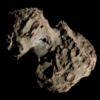astro.wikisort.org - Comet
C/2022 E3 (ZTF) is a long period comet that was discovered by the Zwicky Transient Facility on 2 March 2022.[1] The comet will reach its perihelion on January 12, 2023, at a distance of 1.11 AU (166 million km) and the closest approach to Earth will be on February 1, 2023, at a distance of 0.28 AU (42 million km). The comet is expected to get brighter than magnitude 6 and thus become visible with naked eye.[4]
| Discovery | |
|---|---|
| Discovered by | Zwicky Transient Facility |
| Discovery date | 2 March 2022[1] |
| Orbital characteristics A | |
| Observation arc | 298 days |
| Aphelion | ≈2800 AU (barycentric epoch 1950)[2] |
| Perihelion | 1.112 AU |
| Eccentricity | 1.00025 |
| Orbital period | ≈50000 yr (inbound)[2] |
| Inclination | 109.17° |
| Node | 302.55° |
| Argument of periapsis | 145.82° |
| Earth MOID | 0.221 AU (33.1 million km)[3] |
| Jupiter MOID | 1.743 AU (260.7 million km) |
| Comet total magnitude (M1) | 9.6 |
| Next perihelion | 12 January 2023 |
Observational history
C/2022 E3 (ZTF) was discovered by the Zwicky Transient Facility on 2 March 2022. Upon discovery the comet had an apparent magnitude of 17.3 and was about 4.3 AU (640 million km) from the Sun. The object was initially identified as an asteroid but subsequent observations revealed it had a very condensed coma, indicating it is a comet.[1][5]
By early November 2022, the comet had brightened to magnitude 10 and was appearing to move slowly in Corona Borealis and Serpens as it moved parallelly to Earth.[6] The comet exhibited a green coma and a yellowish dust tail and a faint ion tail. The comet was visible in early evening and will start being visible in the morning sky by the end of November. After that the comet starts moving northwards, passing Bootes, Draco, and Ursa Minor, reaching about 10 degrees from Polaris.[7]
The comet will reach its perihelion on January 12, 2023, at a distance of 1.11 AU (166 million km) and the closest approach to Earth will be on February 1, 2023, at a distance of 0.28 AU (42 million km). The comet is expected to get brighter than magnitude 6 and thus become visible with naked eye.[4] During its closest approach to Earth it will appear near the north celestial pole[8] and be located within the Camelopardalis constellation.[9] On February 10-11 the comet will pass 1.5 degrees from Mars and on February 13 to 15 will pass in front of Hyades star cluster.[7]
References
- "MPEC 2022-F13 : COMET C/2022 E3 (ZTF)". Minor Planet Center. 2022-03-21. Retrieved 2022-08-24.
- Horizons output. "Barycentric Osculating Orbital Elements for Comet C/2022 E3 (ZTF)". Retrieved 2022-08-24. (Solution using the Solar System's barycenter (Sun+Jupiter). Select Ephemeris Type:Elements and Center:@0) Epoch 1950 has PR= 2.91E+07 / 365.25 = 79700 years
- "JPL Small-Body Database Browser: C/2022 E3". JPL. Retrieved 2022-08-24.
- Machholz, Donald (25 March 2022). "EarthSky | New comet might brighten enough for binoculars". earthsky.org. Retrieved 24 August 2022.
- "Electronic Telegram No. 5111- COMET C/2022 E3 (ZTF)". Central Bureau for Astronomical Telegrams. 21 March 2022. Retrieved 24 August 2022.
- Ratcliffe, Martin; Ling, Alister (1 November 2022). "Sky This Month: November 2022". Astronomy.com. Retrieved 4 November 2022.
- "Sneak Peek at Two Promising Comets". Sky & Telescope. 17 November 2022. Retrieved 18 November 2022.
- "Comets to View in 2022". Sky & Telescope. 30 March 2022. Retrieved 24 August 2022.
- Urbain, Tom (10 November 2022). "Starlust.org | Meet Comet C/2022 E3 (ZTF), the next naked-eye comet in the night sky". starlust.org. Retrieved 10 November 2022.
External links
- C/2022 E3 at the JPL Small-Body Database
Другой контент может иметь иную лицензию. Перед использованием материалов сайта WikiSort.org внимательно изучите правила лицензирования конкретных элементов наполнения сайта.
WikiSort.org - проект по пересортировке и дополнению контента Википедии



